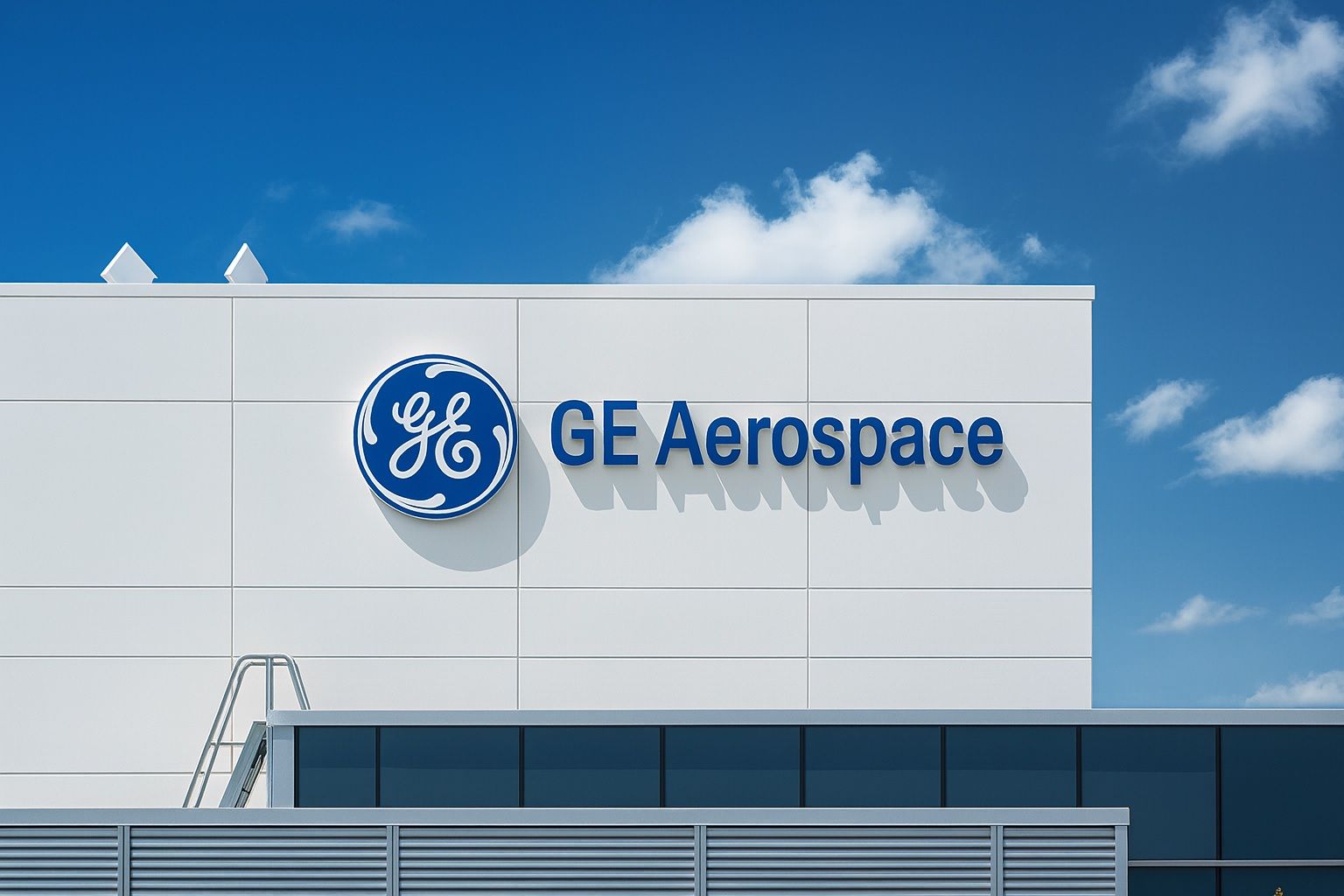- Ticker/Price (Oct 17, 2025): ~$300.14 (NYSE: GE) [1], up ~78% YTD [2]. (52-week range: $159.36–$307.25 [3].)
- Upcoming Earnings (Oct 21): Q3 results due Oct 21 (before market open); analysts expect ~$1.45 EPS on $10.3B sales [4] [5]. Consensus EPS up ~27% YoY [6].
- Recent Moves: CEO Larry Culp’s contract extended through 2027 [7]; GE Aerospace hit by supply chain fixes (higher engine output) and new contracts, including a $5B USAF F110 engine order [8].
- Dividend: Quarterly payout $0.36/sh (yield ~0.5%) [9].
- Analyst Ratings: Consensus rating “Moderate Buy” with avg. target ~$264.50 [10] (Goldman has $305 target [11], UBS ~$321 [12]).
Surging Stock Performance
GE Aerospace (NYSE: GE) shares have been on a tear in 2025, roughly doubling from lows. As of Oct 17, 2025, the stock closed around $300 [13]. That’s up about 78% this year [14] – one of the best performances among mega-cap industrials. The 52-week high is $307.25 and the low was $159.36 [15], reflecting a remarkable rebound as the company emerged as a pure-play aerospace engine maker. (Before April 2024, GE had spun off its energy and healthcare units, leaving “GE Aerospace” as its primary business under ticker GE.)
Trading volumes have been healthy (typically >1M shares daily [16]) and the stock is well above its 50- and 200-day moving averages. Market observers note the stock price is near its all-time high set just in Sept 2025 (around $305) [17]. The rally reflects high investor confidence after a string of positive updates on deliveries, cost control and shareholder returns.
Recent News & Strategic Developments
In mid-October, GE Aerospace announced a marquee partnership with AerCap, a leading aircraft lessor. In a 7-year deal, AerCap will manage the lease-pool services for GE’s new GE9X engine (for Boeing’s 777X), and continue supporting GE’s GE90, GEnx, CF6 and CF34 engine families [18] [19]. GE says this will help ensure the 777X’s GE9X engines have robust support when they enter service [20] [21]. AerCap’s CEO Tom Slattery added that the deal “further strengthens our partnership with GE” and expands their service network for the latest GE engines [22].
Earlier in 2025, GE won a major defense contract. In March, the U.S. Air Force awarded a $5 billion IDIQ contract to GE Aerospace for F110-GE-129 fighter engines used on F-15 and F-16 jets [23]. This secures engine deliveries, spares and services under the U.S. Foreign Military Sales program. GE’s management hailed the deal as “up to $5 billion” in value and reaffirmed the F110’s reputation for performance and reliability [24]. (This deal came as GE also pledged about $1 billion of investment in its U.S. factories and supply chain in 2025 [25].)
GE has also been working to alleviate longstanding supply-chain bottlenecks. As Reuters recently reported, GE expects Leap engine production (for 737MAX/A320neo jets) to ramp 15–20% in 2025 after supply issues eased [26]. CEO Larry Culp noted that “primary suppliers are now shipping over 90% of committed volume, compared with ~50% a year ago” [27], meaning GE is back on track to meet airline orders. The company lifted its 2025 profit outlook on this confidence: it guided to $5.10–5.45 EPS (above analysts’ ~$5.23 estimate) [28], prompting a 7% pop in shares in January. GE also increased share buybacks (to $7B in 2025) and raised its dividend by 30% at that time [29], rewarding shareholders as performance improved.
Leadership at GE Aerospace remains stable. In mid-2024, GE extended Larry Culp’s CEO contract through end-2027 [30]. The board praised Culp’s tenure as “extraordinary”, noting he has delivered debt reduction, cash flow gains and strategic focus [31] [32]. Board members say they are “confident that Larry and the GE Aerospace team will continue their strong execution” and leadership in aerospace [33]. This continuity is seen as a positive for investors who credit Culp with turning around GE’s fortunes.
GE has also been active on environmental and advanced tech fronts. (For example, GE and Beta Technologies are co-developing a hybrid-electric engine generator for future aircraft [34] – a long-term R&D story.) On the labor front, GE settled a new 5-year agreement with the union covering many U.S. engine workers, ensuring production continuity.
Upcoming Earnings and Analyst Views
All eyes are on Oct 21, 2025, when GE Aerospace reports Q3 results before the open. Street expectations are high: analysts forecast around $1.45–1.46 EPS on about $10.3–10.34 billion revenue for the quarter [35] [36]. If met, that would be a significant year-over-year increase (consensus sees ~+15–16% sales growth and ~27% earnings growth [37]). By comparison, Q2 results (July 17 release) delivered $1.66 EPS on $10.15B revenue – well above consensus – with sales +21% YoY [38].
Analyst forecasts have been climbing into the quarter. The Zacks consensus (via FinViz) currently pegs Q3 revenue at $10.34B [39]. Notably, analysts have been nudging estimates upward: GE’s Earnings ESP (Expected Surprise Prediction) is +2.01% [40], meaning the most up-to-date EPS projections exceed the older consensus. Zacks notes that whenever GE had a positive ESP and held a “hold” or better rating, it tended to beat expectations (as it has done in the past four quarters [41]). In fact, the last quarter saw a 16% surprise as GE earned $1.66 vs $1.43 expected [42]. If history repeats, investors expect another upside beat this week.
Much of the focus for earnings will be on guidance. Management has already signaled that 2025 profits could exceed earlier forecasts. Back in January it had guided $5.10–5.45 EPS (beating forecasts) [43], and by mid-year raised 2025 targets to $5.60–5.80 EPS [44] (from prior $5.10–5.45). These upgrades were driven by improved Leap engine output and strong services sales. GE also noted about $500M of tariff headwinds for 2025, but has largely mitigated these through operational gains [45] [46].
Analyst commentary is generally bullish. For example, Goldman Sachs raised its price target from $271 to $305 (a ~4.5% upside from then-current prices) after GE’s last quarter [47]. UBS hiked its target even further (to $321) and rated GE a Buy [48]. Royal Bank of Canada also gave an “outperform” rating with a $300 target. In aggregate, 15 analysts now recommend Buy versus 2 Hold, giving GE a Moderate Buy consensus [49]. These firms cite the engine aftermarket strength and backlog growth as drivers.
On the other hand, some caution that the stock is richly valued at ~40× earnings (forward) [50]. CoinCodex model projections (tech-driven forecasts) show a wide range of outcomes: one algorithm forecast a “bearish” 2026 price near $241 vs a “bullish” near $297 [51]. The main bull case is that GE’s CFM joint-venture (GE-Safran) has captured essentially 100% of 737 MAX orders and a dominant share of A320neo engines [52], ensuring decades of high-margin service revenue (~70% of commercial revs). The massive $175+ billion engine backlog gives long-term visibility [53]. In a bull scenario, some forecasts see GE reaching as high as $666 by 2030 [54].
Bear-case worries center on execution risks. Analysts note that much growth is already priced in, and any hiccup in supply chain or tariffs could cause swings [55]. New engine programs (like LEAP and GE9X) require heavy investment before yielding profit [56]. CoinCodex predicts GE might enter a consolidation phase in 2026, trading in a moderately wide band as the company converts backlog into cash flow [57].
Sector & Peer Context
The broader aerospace sector has been buoyant. Aircraft OEMs like Boeing and Airbus are steadily increasing jet production to meet booming travel demand, which in turn lifts engine demand. Boeing recently won FAA approval to boost 737 MAX output to 42/month, which should drive more LEAP engine orders [58]. GE’s engine market share (via CFM) means it benefits directly from this upcycle.
Even purely defense news is supportive. Besides the F110 Air Force deal [59], GE has engines on the new F-35 and other military platforms, capturing U.S. and allied spending. This ties into a general surge in aerospace/defense stocks – TS2.tech notes that European defense firms rallied after geopolitical developments (e.g. Trump-Putin summit) [60], underlining a higher defense-spending backdrop.
Looking at peers, rival engine-maker Rolls-Royce (UK) has likewise seen a spectacular run. TS2.tech reports Rolls-Royce shares nearly doubled in 2025, hitting record highs as civil engine services and new defense contracts lifted profits [61]. Rolls’ 1H25 underlying profit jumped 50% YoY to £1.7B, prompting a full-year guidance boost [62]. Similarly, United Technologies/Raytheon (Pratt & Whitney) and MTU Aero Engines are capitalizing on jet and military demand. In this context, GE’s strong performance looks in line with a buoyant engine sector.
However, unlike some peers, GE Aerospace is still early in its run. Before the 2024 breakup, GE’s power/energy divisions had depressed the conglomerate’s stock. Now, as a lean pure-play, GE is being valued more like a fast-growing tech stock. For perspective, Morningstar says Rolls-Royce (FTSE: RR) joined the FTSE-100’s top performers, and UBS analysts are raising that stock’s targets, reflecting the whole sector’s momentum [63] [64]. GE is trading at similarly lofty multiples, so any sector rotation could affect it.
Outlook: Short-Term vs. Long-Term
In the short term, GE Aerospace’s stock will likely move on the upcoming earnings and forward guidance. A beat on Oct 21st could propel shares higher, especially given the positive analyst sentiment. Conversely, any cautious tone on supply issues or airline order rates could cause a pullback. Technical traders will be watching if GE can clear resistance near $300–305 (recent highs).
In the long term, most analysts remain optimistic. Management has committed to generous shareholder returns (high 70% cash-return target) [65], and expects aerospace demand to remain strong for years. GE forecasts operating profit climbing to $7–7.5B by 2025 (from $6–6.5B in 2024) [66] and even targeted $10B by 2028 [67], reflecting confidence in enduring demand. Larry Culp emphasizes that “demand isn’t our challenge” [68] — there are more orders than capacity, meaning future growth depends on execution. If GE can continue ramping production and absorbing tariffs, bulls argue its revenue and free cash flow will grow strongly.
Most long-term price targets are in the $300–350 range. FactSet’s analyst consensus (via Benzinga) averages around $317 for 2025 [69]. CoinCodex’s upper forecasts reach $666 by 2030 [70], but those assume perfect execution and continued tailwinds. Even conservative “bear” scenarios still have GE mid-$200s in the near term [71]. In summary, the street sees GE Aerospace as a high-growth, high-valuation stock: it has stellar backlog and market position, but its premium price leaves little margin for error.
The Bottom Line: As of Oct 18, 2025, GE Aerospace is riding a strong uptrend on robust engine demand and improving execution. Near-term catalysts (Q3 earnings, backlog updates) dominate the outlook – and analysts mostly expect positive surprises [72] [73]. Longer-term, GE’s outlook hinges on its ability to sustain high production, manage costs (tariffs, supply chains) and continue returning cash to investors. With peers also booming, the aerospace sector tailwinds favor GE, but investors will watch closely if its lofty valuation remains justified by growth.
Sources: Company releases and filings [74] [75]; Reuters and industry news [76] [77] [78]; financial analysts (MarketBeat, Zacks) [79] [80] [81]; and TS2.tech sector reports [82] [83]. Each data point and quote above is cited accordingly.
References
1. www.reuters.com, 2. www.intelligentinvestor.com.au, 3. www.reuters.com, 4. www.marketbeat.com, 5. finviz.com, 6. finviz.com, 7. www.reuters.com, 8. www.reuters.com, 9. www.marketbeat.com, 10. www.marketbeat.com, 11. www.marketbeat.com, 12. www.marketbeat.com, 13. www.reuters.com, 14. www.intelligentinvestor.com.au, 15. www.reuters.com, 16. www.intelligentinvestor.com.au, 17. www.benzinga.com, 18. www.geaerospace.com, 19. avitrader.com, 20. www.geaerospace.com, 21. www.geaerospace.com, 22. www.geaerospace.com, 23. www.reuters.com, 24. www.reuters.com, 25. www.reuters.com, 26. www.reuters.com, 27. www.reuters.com, 28. www.reuters.com, 29. www.reuters.com, 30. www.reuters.com, 31. www.reuters.com, 32. www.flightglobal.com, 33. www.flightglobal.com, 34. www.geaerospace.com, 35. www.marketbeat.com, 36. finviz.com, 37. finviz.com, 38. www.marketbeat.com, 39. finviz.com, 40. finviz.com, 41. finviz.com, 42. finviz.com, 43. www.reuters.com, 44. www.reuters.com, 45. www.benzinga.com, 46. www.benzinga.com, 47. www.marketbeat.com, 48. www.marketbeat.com, 49. www.marketbeat.com, 50. www.marketbeat.com, 51. www.benzinga.com, 52. www.benzinga.com, 53. www.benzinga.com, 54. www.benzinga.com, 55. www.benzinga.com, 56. www.benzinga.com, 57. www.benzinga.com, 58. www.reuters.com, 59. www.reuters.com, 60. www.reuters.com, 61. ts2.tech, 62. ts2.tech, 63. ts2.tech, 64. ts2.tech, 65. www.reuters.com, 66. www.reuters.com, 67. www.reuters.com, 68. www.reuters.com, 69. www.benzinga.com, 70. www.benzinga.com, 71. www.benzinga.com, 72. finviz.com, 73. finviz.com, 74. www.reuters.com, 75. www.geaerospace.com, 76. www.reuters.com, 77. www.reuters.com, 78. ts2.tech, 79. www.marketbeat.com, 80. finviz.com, 81. www.marketbeat.com, 82. ts2.tech, 83. www.benzinga.com







